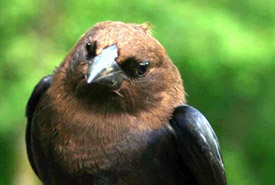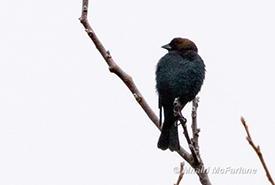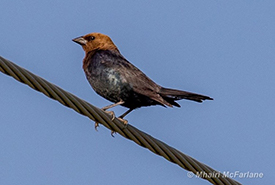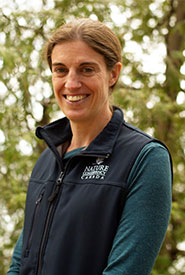Mhairi’s bird of the day: Brown-headed cowbird

Brown-headed cowbird (Photo by Stephen Davis)
Spotted on March 19, 2020
Brown-headed cowbird
Molothrus ater
molos: “struggle or “battle” in ancient Greek
throsko: “to sire” or “to impregnate” in ancient Greek
ater: “dull black” in Latin
For the last 10 years, I have been recording my bird observations on my daily bike commute to work, before we started working from home in light of the COVID-19 outbreak. My colleagues, who have been enjoying my daily updates of my sightings, invited me to share my observations in this four-part blog series.
I needed some time in nature after falling out of my regular routine of cycling to the office via a city park, so I decided to work a slightly later shift at home today and took some time in the morning to visit a local conservation area. [Ed: As this occurred in the early days of COVID-19, visiting local natural areas was still permitted.]
Seeing as it is just March, there are many birds left to see for the year! Migration is already starting, so every day, there is a chance of seeing a new species. Birders use the term “FoY,” or “First of Year,” to refer to these birds. I was excited to see what FoYs I might get today!

My FoY brown-headed cowbird, in disappointingly poor light! (Photo by Mhairi McFarlane/NCC)
The first one was sitting in a tree in the parking lot. It’s been a good eight months since I’ve heard the distinctive sound of a sneaker squealing on a shiny gymnasium floor: brown-headed cowbird! It’s always a good feeling to find a new bird right at the beginning of an expedition.
Brown-headed cowbirds are an interesting species. They don’t build their own nests, but lay their eggs in the nests of other species. If the host birds do not recognize or eject the cowbird egg, they incubate it along with their own, and raise the resulting chick. Cowbird chicks develop faster than their host’s chicks, so being parasitized can often result in the host birds raising only one cowbird chick, while their own young starve.
Brown-headed cowbirds are primarily an open country, or grassland, species, and have spread into new areas in North America as humans cleared forests for agriculture. This has put them into closer contact with birds that have never experienced cowbirds before. On top of this, as we have reduced the size of forest patches, cowbirds are able to penetrate deeper into that habitat. Forest interior species, including wood thrush and hooded warblers, are now parasitized by cowbirds. They may be less well adapted to cope with this than open country species, such as bobolink and song sparrow.
This is one of the key reasons why we often talk about “interior forest habitat,” and many of our conservation goals include increasing forest patch size via restoration: essentially, planting wildflowers, shrubs and trees on degraded land beside existing forest to (eventually!) make it bigger. With some clever mapping, we can see which patches might be the most strategic to restore in order to buffer existing forest and ultimately increase the area that is “interior.”

A better photo of a brown-headed cowbird in better light from a few years ago (Photo by Mhairi McFarlane/NCC)
Despite their bad reputation, cowbirds are pretty neat little birds. You can find them in flocks with red-winged blackbirds, European starlings and common grackles in rural and urban areas. Look for the chestnut brown heads of the males when scanning through flocks of other black birds.
I continued my wandering and ended up seeing another two FoYs: two great-blue herons flew overhead, and I managed to pick up a rather distant pied-billed grebe. This takes me up to 67 species in my county for 2020.
Here’s my ebird checklist: https://ebird.org/checklist/S65968591


